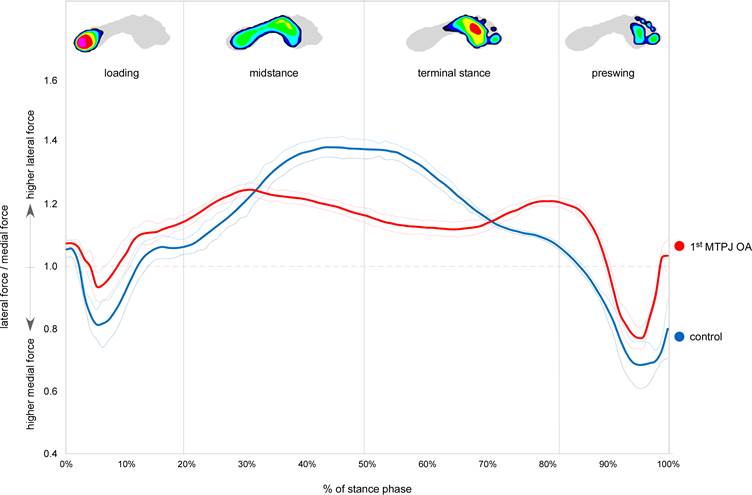Session Information
Date: Tuesday, November 7, 2017
Title: ARHP Rehabilitation Science
Session Type: ARHP Concurrent Abstract Session
Session Time: 2:30PM-4:00PM
Background/Purpose: Osteoarthritis of the first metatarsophalangeal joint (1st MTPJ OA) is a common and disabling condition characterised by symptoms of joint pain and stiffness, formation of a dorsal exostosis, and progressive reduction in range of motion of 1st MTPJ dorsiflexion. Because the 1st MTPJ plays an important role in transferring the body’s centre of mass over the foot during the propulsive phase of gait, individuals with 1st MTPJ OA frequently adopt an apropulsive walking pattern. The objective of this study was to compare centre of pressure characteristics during walking in individuals with and without 1st MTPJ OA, in order to provide insights into alterations in foot function associated with this condition.
Methods: Twenty people with 1st MTPJ OA and 20 asymptomatic controls matched for age, sex and body mass index underwent gait analysis using the emed®-x400 plantar pressure system (Novel GmbH, Germany). Average and maximum centre of pressure velocity and lateral-medial force index during loading, midstance, terminal stance and preswing were compared between the groups, adjusting for contact time.
Results: During the preswing phase of gait, maximum centre of pressure velocity was significantly slower in individuals with 1st MTPJ OA (0.78 ± 0.19 vs 1.13 ± 0.36 m/sec; p=0.003), and both average and maximum lateral-medial force indices were significantly higher in individuals with 1st MTPJ OA (0.98 ± 0.14 vs 0.82 ± 0.13; p<0.001 and 1.37 ± 0.29 vs 1.15 ± 0.15; p=0.008, respectively). See Figures 1 and 2. Non-weightbearing 1st MTPJ dorsiflexion range of motion was significantly associated with maximum centre of pressure velocity (r=0.54, p<0.001) and average lateral-medial force index (r=-0.44, p=0.004) during preswing.
Conclusion: These findings suggest that individuals with 1st MTPJ OA may generate less forward momentum when walking due to a lateral transfer of force during propulsion, possibly due to decreased range of 1st MTPJ dorsiflexion.
To cite this abstract in AMA style:
Menz H, Auhl M, Tan J, Munteanu S. Centre of Pressure Characteristics during Walking in Individuals with and without First Metatarsophalangeal Joint Osteoarthritis [abstract]. Arthritis Rheumatol. 2017; 69 (suppl 10). https://acrabstracts.org/abstract/centre-of-pressure-characteristics-during-walking-in-individuals-with-and-without-first-metatarsophalangeal-joint-osteoarthritis/. Accessed .« Back to 2017 ACR/ARHP Annual Meeting
ACR Meeting Abstracts - https://acrabstracts.org/abstract/centre-of-pressure-characteristics-during-walking-in-individuals-with-and-without-first-metatarsophalangeal-joint-osteoarthritis/


